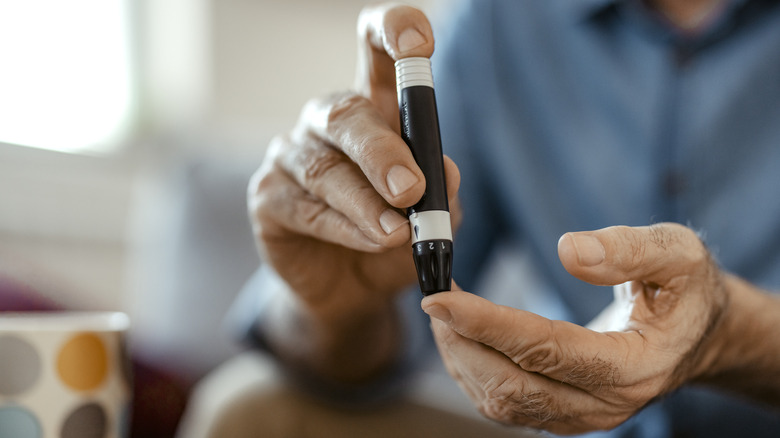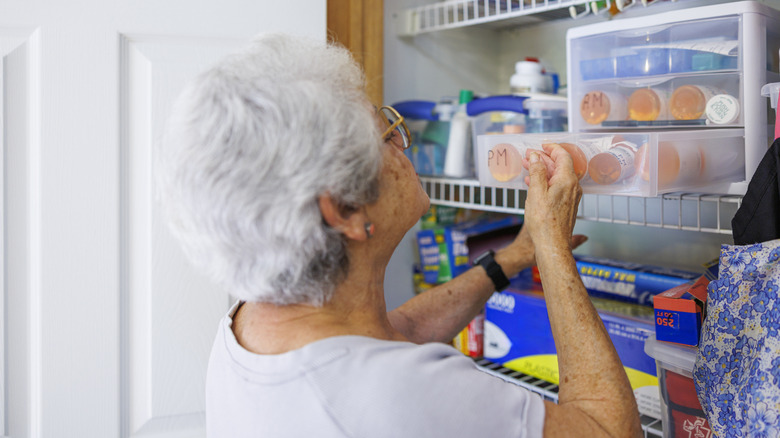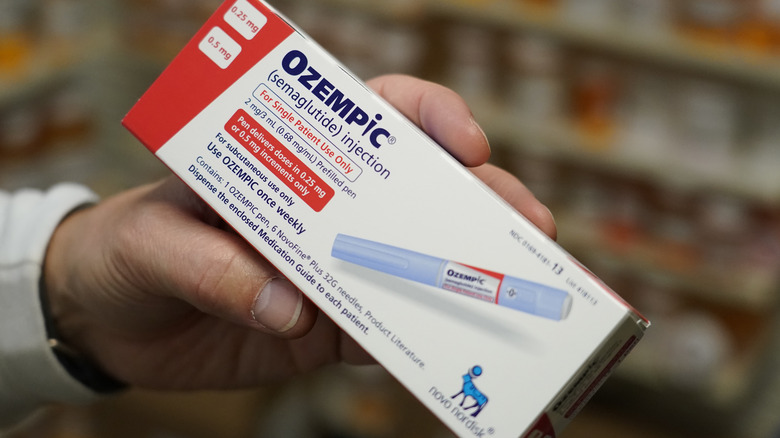The Trulicity Commercial Explained: Drug Uses, Side Effects, And More
The Trulicity pen — an injectable drug for patients to manage their type 2 diabetes — has been around for quite some time. According to Drugs.com, the medication was first approved by the U.S. Food and Drug Administration (FDA) nearly a decade ago in 2014. Having been around for so long, Trulicity has released several different commercials over the years. Many of their spots follow a common theme, including their "Truly Powerful" series which features people in different career fields declaring, "I have the power to lower my A1C."
In recent years, the company has released another commercial series featuring the testimonials of famous athletes who have a loved one diagnosed with type 2 diabetes. Airing in 2021, this included two-time U.S. Olympic medalist Laurie Hernandez in a Trulicity TV spot titled "Still Got It." While it looks as if no new spots have been released in this series since 2022, the last one featured Olympic figure skater Madison Chock who expressed feeling confident in her mother's management of her type 2 diabetes. In addition to highlighting personal stories, the commercials feature a long list of potential side effects. For those interested in more information, we're tackling this list slowly and thoroughly and will explain who the drug may or may not be suited for.
What is Trulicity and what does it do?
Going by the generic name dulaglutide [DOO-la-GLOO-tide], Trulicity is manufactured by Eli Lilly. Injected once weekly, the drug is intended to be used in tandem with diet and exercise to help regulate blood sugar levels in adults and children at least 10 years of age diagnosed with type 2 diabetes (via Trulicity). It does so by limiting the amount of sugar dispersed into the bloodstream by the liver, slowing the passage of food from the stomach, and boosting the release of insulin from the pancreas in response to blood sugar spikes after eating. For adult patients with type 2 diabetes who are also considered high risk for cardiovascular events, Trulicity lowers one's susceptibility to stroke, heart attack, or death. Trulicity is not for patients diagnosed with type 1 diabetes.
Trulicity studies involving other diabetes drugs revealed that between 50% and 67% of adult patients with an average starting A1C level between 8% and 8.6% saw A1C levels drop below 7% with the use of four doses. The American Diabetes Association explains that A1C is a percentage that indicates your average blood sugar levels over the last couple of months. Larger percentages indicate higher blood sugar levels. A percentage of 6.5% or higher is indicative of diabetes.
Trulicity side effects
In comparison to a placebo, clinical trials showed some common side effects of Trulicity including nausea, diarrhea, vomiting, abdominal pain, and decreases in appetite, as outlined in the company's Medication Guide.
More severe side effects have also been noted in association with Trulicity. This includes the potential development of thyroid tumors, including those that may be cancerous. Patients should contact their doctor if they experience swelling or lumps in the neck, difficulty swallowing, hoarseness, or shortness of breath. Pancreatitis can also occur in Trulicity patients. Contact your physician promptly if you develop severe abdominal pain that does not subside. Alternatively, facial swelling, dizziness, fainting, a very rapid heart rate, rash, hives, or trouble breathing can be indicative of a severe allergic reaction in need of medical attention. Other serious side effects may include vision changes, gallbladder issues, severe stomach problems, or kidney failure. A patient may also be at risk for hypoglycemia (low blood pressure) if they're taking another blood sugar-lowering medication at the same time. Symptoms of hypoglycemia include blurred vision, slurred speech, headache, lightheadedness, weakness, sweating, confusion, and more.
Visit Trulicity's full Medication Guide for a list of all possible side effects.
Trulicity dosage
Administered through a needle, Trulicity should be injected underneath the skin of either the stomach, upper arm, or thigh. Doses should be administered through the user-friendly pen once a week and can be taken with or without a meal at any time during the day. Patients should rotate between the three injection sites weekly.
For adults, the recommended dose to start with is 0.75 milligrams (mg) weekly, according to the company's Medication Guide. Those in need of additional blood sugar control may be advised to increase the dose to 1.5 mg weekly or by additional 1.5 mg increments after having been on the current dose for at least four weeks. The maximum dosage amount for adults is 4.5 mg. Children ages 10 or older are also recommended to start with a 0.75 mg dose. However, their maximum allowed dosage is 1.5 mg, and only after they have been taking 0.75 mg for four weeks or more.
Should a patient miss a dose, administer the medication promptly as long as there are still 72 or more hours remaining before they are due for the next dose. If less than 72 hours remain, skip the missed dose and take the next dose as scheduled. If you take too much of the drug, call your doctor or go to the emergency room immediately. To speak with a specialist in the event of a suspected poisoning, call Poison Control at 1‑800‑222‑1222.
Trulicity precautions
Because of Trulicity's potential adverse effects on the thyroid, kidney, gallbladder, and more, people with certain health conditions are advised against taking the drug. This includes individuals who have a personal medical history, or family medical history, of a thyroid cancer known as medullary thyroid carcinoma (MTC), as per Trulicity's Medication Guide. This is also true for patients diagnosed with an endocrine system condition known as Multiple Endocrine Neoplasia syndrome type 2 (MEN 2). Experts at UCLA Health explain that MEN 2 is a kind of thyroid cancer that occurs simultaneously with adrenal gland cancer.
Patients should inform their doctor of any pancreas, kidney, or liver issues (past or present) before taking Trulicity. The same is true for people with severe stomach problems or a medical history of diabetic retinopathy. Your doctor can help determine whether or not the medication may be right for you. People who are pregnant, plan to become pregnant, breastfeeding, or plan to breastfeed should also talk to their physician as it is not known whether the drug may pose health risks to the baby.
Avoid taking Trulicity if you are on these medications
Make your doctor aware of all medications you take including vitamins, herbs, supplements, and over-the-counter (OTC) medicines. This is particularly important if you take other diabetes treatment drugs such as:
- insulin
- sulfonylureas
When used with Trulicity, these drugs can increase one's risk of hypoglycemia. While Trulicity can be taken with insulin in some cases, the drugs should never be mixed into the same injection and should not be injected right next to one another. Additionally, because Trulicity slows the rate at which food leaves the stomach, it can potentially slow the absorption rates of certain oral medications. Therefore, the use of medications that are categorized as narrow therapeutic index (NTI) drugs — or medicines in which even minor changes in dose or blood concentration can be life-threatening — should be monitored carefully. This includes drugs like Warfarin.
According to Drugs.com, Trulicity has 252 known drug interactions and two moderate food/alcohol interactions. Alcohol consumption may put a patient with diabetes at risk of increases or decreases in blood sugar levels. Patients with unmanaged diabetes, high triglycerides, pancreatitis, or nerve damage should refrain from drinking alcohol. Those who are allergic to dulaglutide should not take Trulicity. Be sure to keep your doctor up to date with any new medications you're taking or considering taking. As this is not a comprehensive list, visit Trulicity's Medication Guide for more information about potential drug interactions.
How much does Trulicity cost?
Trulicity has a list price of $977.42 per month yet individual costs will vary from person to person (via Lilly Pricing Info). For over 90% of patients with health insurance through their employer or a private individual policy, the cost of a monthly Trulicity prescription falls between $0 and $30 with a remaining monthly cost of approximately $239. The Trulicity Savings Card may reduce the price of a one-month supply of Trulicity to $25. For those with Medicare Part D coverage, roughly 70% of monthly prescriptions cost between $0 and $100 with remaining prescriptions priced at approximately $207 a month.
Those who qualify for the Extra Help program will pay between $4 and $9 per prescription. Similarly, Medicaid recipients usually pay between $4 to $9 each month for drugs like Trulicity. People without insurance often face costs close to the drug's list price. To find out if you might be eligible for Medicaid coverage, the company suggests visiting Medicaid.gov or visiting Medicine Assistance Tool for information about public and private assistance plans.
What's the difference between Trulicity and Ozempic?
Trulicity and Ozempic are both injectable drugs that serve the same purpose: they work by lowering patient blood sugar levels. According to Drugs.com, both are classified as incretin mimetics, a type of drug that acts similarly to the body's GLP-1 hormone, which prompts the release of insulin and reduces the secretion of blood sugar-raising hormones from the liver. Seeing as they operate so similarly, are there any differences between the two?
One of the differences between Trulicity and Ozempic is their half-life, or how long it takes for half of the drug's concentration to filter out of the body. For Trulicity, this process takes 120 hours while Ozempic has a half-life of 168 hours. The two also differ slightly when it comes to the number of drug interactions, with Ozempic reported to have 250 compared to Trulicity's 252 known interactions. While the two drugs do share some overlap in their drug-disease interactions, gastroparesis, pancreatitis, and thyroid carcinoma are the more severe risks associated with Trulicity, while thyroid cancer and suicidal behavior and ideation have been seen more in connection with Ozempic.







